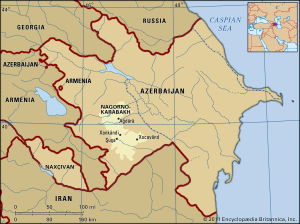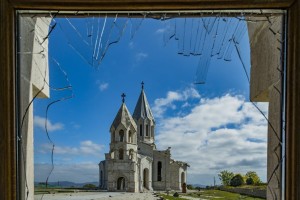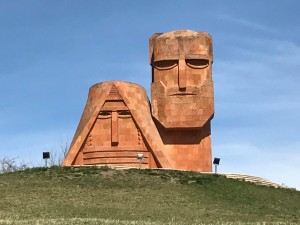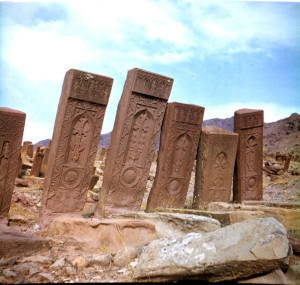Old men being beheaded, and prisoners of war, with hands tied, shot in cold blood—you would thi nk these brutal images would have elicited worldwide condemnation. Maybe 2020 was just too difficult a year for people to acknowledge one more tragedy. The men killed were Armenian. The apparent perpetrators were members of the Azerbaijani military, who posted videos online. Recently, at least, mainstream media has covered these atrocities, as in Liz Cookman’s article, “Videos from Nagorno-Karabakh conflict prompt accusations of war crimes,” Washington Post (December 26, 2020).
nk these brutal images would have elicited worldwide condemnation. Maybe 2020 was just too difficult a year for people to acknowledge one more tragedy. The men killed were Armenian. The apparent perpetrators were members of the Azerbaijani military, who posted videos online. Recently, at least, mainstream media has covered these atrocities, as in Liz Cookman’s article, “Videos from Nagorno-Karabakh conflict prompt accusations of war crimes,” Washington Post (December 26, 2020).
These depraved acts occurred during the brutal war launched by Azerbaijan and Turkey on September 27, 2020, against Armenians in Nagorno-Karabakh, an ethnic Armenian region within Azerbaijan. Armenians have lived in Nagorno-Karabakh (or Artsakh, as Armenians call it) for more than 2,000 years, but it was annexed as an autonomous zone by Joseph Stalin to Azerbaijan in the early 1920s. After six weeks of war in 2020, a tenuous cease fire came into effect in early November, but lives are still at risk.
This six-week war occurred in a remote region of the world with broad international significance. While it is a territorial conflict in the south Caucasus mountains, it is bordered by competing power brokers Russia, Turkey and Iran. Numerous oil and gas pipelines run from the Caspian Sea in Azerbaijan into Europe. The international, geo-political consequences from warfare to the stability of the region loom large.
Even more pressing are issues of justice and human rights. The Armenians of Nagorno-Karabakh voted to declare independence from Azerbaijan in the late 1980s and unite with Armenia. Azerbaijan refused and war broke out in the early 1990s between Armenia and Azerbaijan, which by then were independent countries after the break-up of the Soviet Union. A cease fire was declared in 1994, after more than 30,000 people died and 1 million were displaced. Ethnic Armenians governed Artsakh and the seven additional territories they occupied during that war while international negotiators tried unsuccessfully to resolve the conflict for more than two decades. Azerbaijan and Turkey abandoned negotiations and launched a full-scale assault this past September, committing war crimes and human rights violations that must be investigated.
 During the six weeks of war in 2020, Azerbaijan bombed Artsakh’s two major cities with cluster bombs. Bombing, constant shelling and drone strikes killed Armenian civilians, destroyed homes and buildings and damaged ancient Armenian cathedrals. Azerbaijan reportedly used banned white phosphorus to ignite forests in Artsakh, which will “not only destroy valuable ecosystems and habitats and put threatened species at the risk of extinction but will contaminate rivers and underground waters for years, thus turning into a major threat of regional scale for all the people and wildlife living in the region.” Lukas Andriukaitis, “Satellite imagery shows environmental damage of reported white phosphorus use in Nagorno Karabakh,” Digital Forensic Research Lab (November 12, 2020). Azerbaijan denies this claim.
During the six weeks of war in 2020, Azerbaijan bombed Artsakh’s two major cities with cluster bombs. Bombing, constant shelling and drone strikes killed Armenian civilians, destroyed homes and buildings and damaged ancient Armenian cathedrals. Azerbaijan reportedly used banned white phosphorus to ignite forests in Artsakh, which will “not only destroy valuable ecosystems and habitats and put threatened species at the risk of extinction but will contaminate rivers and underground waters for years, thus turning into a major threat of regional scale for all the people and wildlife living in the region.” Lukas Andriukaitis, “Satellite imagery shows environmental damage of reported white phosphorus use in Nagorno Karabakh,” Digital Forensic Research Lab (November 12, 2020). Azerbaijan denies this claim.
Turkey secretly brought in Syrian mercenaries to fight for Azerbaijan, serving on the front lines and suffering heavy casualties during ground assaults in this mountainous area. Syrian survivors, in interviews afterwards, said they were told they would be border guards, paid over $1,000/month, a fortune to Syrians from war-torn and desperate communities. Those who survived watched their friends die in a war and region they knew nothing about.
In the air, sophisticated Israeli and Turkish drones inflicted massive damage to tanks, artillery, rocket launchers, and air defenses of the Armenians in Artsakh: “Armenia lacked enough modern weapons to combat the Azerbaijani drone fleet or to launch a strong one of its own,” wrote my brother David Ignatius, a Washington Post columnist, in “What’s needed for a first step toward peace for Armenia and Azerbaijan,” Washington Post (October 20, 2020).
The combined forces of Turkey, Azerbaijan, mercenaries and Turkish and Israeli drones proved too much for the Armenians of Artsakh. Russia did not come to Armenia’s aid although Russia has a defense treaty with Armenia, since this war was primarily fought in Artsakh. Thousands were killed on both sides until Russia brokered a cease fire agreement in early November 2020. Russia, which sells arms and military equipment to both sides, now polices the agreement, and the future of Armenians in the region is perilous. Although the November cease fire stopped the fighting, it left the status of Artsakh unresolved. It also left the fate of Armenian prisoners of war in Azerbaijan unknown as Azerbaijan delays releasing them. Under the Geneva Convention on the Treatment of Prisoners of War, prisoners must be returned immediately after hostilities cease.
Armenians were fighting to protect what is left of their homeland, culture and heritage. More than 100 years ago, the Ottoman Empire (precursor to modern-day Turkey) carried out systematic killings and deportations starting in 1915, resulting in genocide of an estimated 1.5 million Armenians. Turkey has not acknowledged the genocide although the U.S. Congress finally did in 2019, as did the Pope in 2015. The consequences of silence are devastating. No one could have said it better than Adolf Hitler himself, scheming his own genocidal rampage against men, women, and children in the 1930s and feeling assured that no one would care: “Who, after all, speaks today of the annihilation of the Armenians?”
To increase awareness about Armenians and Artsakh and to counter Azerbaijani disinformation, numerous celebrities have spoken out against genocidal acts by Turkey and Azerbaijan. System of a Down wrote two songs for Artsakh: “Protect the Land” and “Genocidal Humanoidz.” Kim Kardashian West donated $1 million in humanitarian aid. Cher posted a video condemning the ethnic cleansing of Armenians in Artsakh and calling on people in the U.S. to contact their congressional representatives and send aid.
Azerbaijan. System of a Down wrote two songs for Artsakh: “Protect the Land” and “Genocidal Humanoidz.” Kim Kardashian West donated $1 million in humanitarian aid. Cher posted a video condemning the ethnic cleansing of Armenians in Artsakh and calling on people in the U.S. to contact their congressional representatives and send aid.
Sports celebrities have also raised their voices. The New England Patriots Director of Football Berj Najarian, Coach Bill Belichick and team members spoke out against the deadly drone attacks on Armenians by Azerbaijan. The Italian Roma football team, where Armenian-born star midfielder Henrich Mkhitaryan plays, sent humanitarian relief to Armenia. And many others, known and unknown, have donated millions, investigated war crimes allegations and written about what is at stake.
Are Armenians exaggerating the threat of another genocide? Not if you listen to chilling statements from the rulers of Turkey and Azerbaijan. At a military parade in Azerbaijan in December 2020 celebrating the ceasefire, President Aliyev of Azerbaijan declared that Yerevan, which is the capital of Armenia, and several provinces are Azerbaijan’s historical lands. President Erdogan of Turkey, for his part, exulted, “Today, may the soul of . . . Enver Pasha . . . be happy.” Enver Pasha was Minister of War more than 100 years ago in the Ottoman Empire and one of the primary architects of the Armenian genocide.
Another present danger is the destruction of Armenian cultural heritage in the region. A leading scholar on medieval Armenian architecture of Eastern Turkey Christina Maranci warned that “both Azerbaijan and Turkey have continuous, well-documented policies of destroying the Arme nian cultural heritage found in their territories,” as happened recently in another Azerbaijan territory, Nakhichevan. “Azerbaijan deliberately wiped Nakhichevan clean of its Armenian culture, destroying more than 89 medieval churches, 5,840 khachkars (carved cross-stones), and 22,000 historical tombstones,” culminating in the final destruction in 2005 of the remaining cross-stones in “the world’s largest medieval Armenian cemetery.” Christina Maranci, “Cultural heritage in the crosshairs once more,“ Wall Street Journal (November 19, 2020). Complete destruction is feared for the ancient Armenian churches and monasteries of Artsakh.
nian cultural heritage found in their territories,” as happened recently in another Azerbaijan territory, Nakhichevan. “Azerbaijan deliberately wiped Nakhichevan clean of its Armenian culture, destroying more than 89 medieval churches, 5,840 khachkars (carved cross-stones), and 22,000 historical tombstones,” culminating in the final destruction in 2005 of the remaining cross-stones in “the world’s largest medieval Armenian cemetery.” Christina Maranci, “Cultural heritage in the crosshairs once more,“ Wall Street Journal (November 19, 2020). Complete destruction is feared for the ancient Armenian churches and monasteries of Artsakh.
In light of these concerns, UNESCO is set to send a mission to Artsakh to evaluate cultural heritage. Azerbaijan, so far, has refused to let them in after several requests. UNESCO planned this independent mission of experts to inventory significant cultural properties as a first step for safeguarding them. Both countries have an obligation to protect cultural heritage under the 1954 Convention for the Protection of Cultural property in the event of armed conflict, which both Armenia and Azerbaijan signed.
What can be done? Raising awareness, speaking out, contacting Congress and international organizations and tribunals, sending humanitarian support for refugees from Artsakh, learning about Armenian cultural heritage in Artsakh and engaging in similar activities—all these actions will help to ensure that the world will notice and stop further acts of genocide against Armenians.


